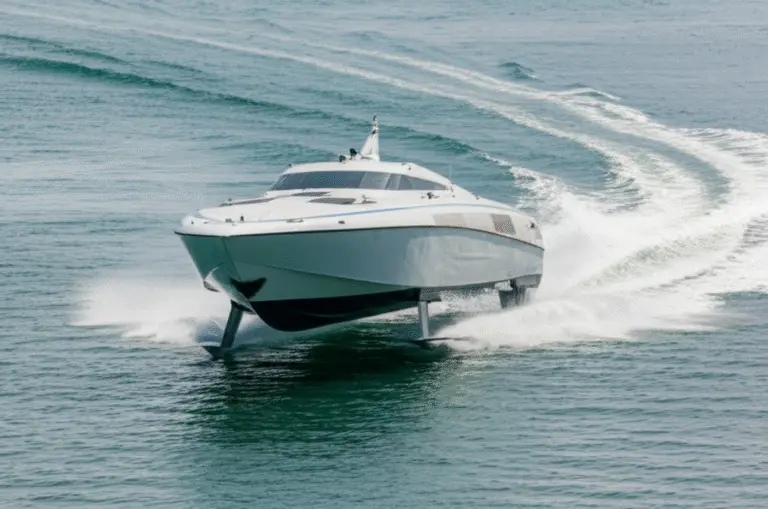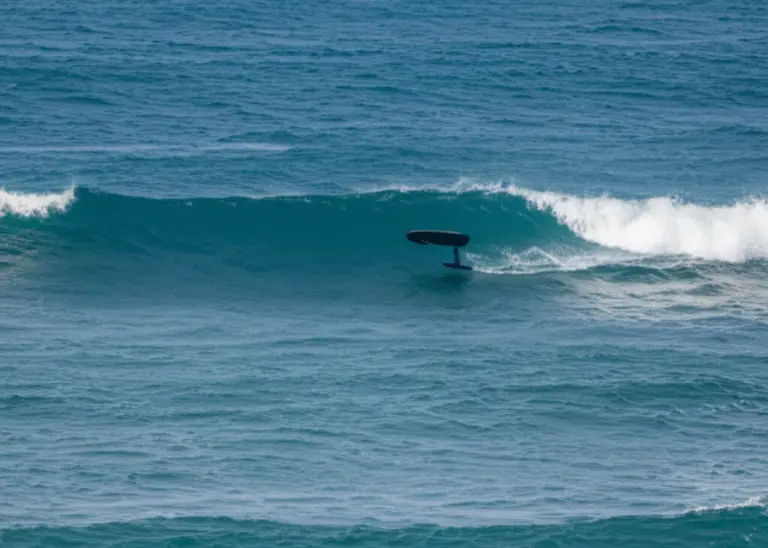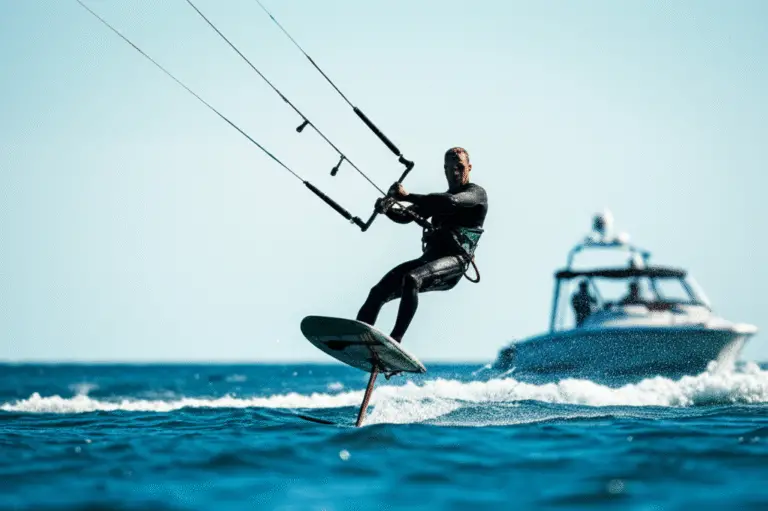Support our hydrofoil educational content for free when you purchase through links on our site. Learn more
Foiling vs Surfing: 11 Epic Differences You Need to Know in 2025 🌊🚀
Picture this: you’re gliding silently just inches above the water, the ocean breeze in your face, feeling almost weightless — but wait, that’s not traditional surfing! It’s hydrofoiling, the futuristic cousin of surfing that’s turning heads and rewriting the rules of wave riding. But how does foiling really stack up against classic surfing? Which one suits your style, skill, and stoke?
In this deep dive, we break down 11 essential differences between foiling and surfing—from gear and technique to culture and safety. Whether you’re a seasoned surfer curious about foiling or a water sports newbie wondering where to start, we’ve got the insights, personal stories, and expert tips to help you decide your next epic ride. Ready to find out if foiling is the future or if surfing still reigns supreme? Let’s ride the wave of knowledge together!
Key Takeaways
- Foiling offers a smoother, faster ride by lifting you above the water, allowing you to surf smaller waves and even flat water with electric or tow-in assistance.
- Surfing remains the classic, tactile wave-riding experience, relying on wave size and shape, with a lower cost of entry and a rich cultural heritage.
- Learning to foil is more challenging initially but can lead to quicker progression and longer rides.
- Safety gear is crucial for foiling due to sharp foil wings; surfing has its own risks but generally less gear needed.
- Foiling’s versatility spans wing foiling, e-foiling, and kite foiling, expanding where and how you can ride.
- Our Hydrofoiling™ team recommends trying both to find your perfect ocean connection!
👉 Shop top gear for your next ride:
- Lift Foils Hydrofoil Boards | Slingshot Sports Foil Gear | Channel Islands Surfboards | Firewire Surfboards
Table of Contents
- ⚡️ Quick Tips and Facts
- The Evolution of Riding Waves: From Traditional Surfing to Hydrofoiling’s Rise
- What Exactly Are We Talking About? Defining Foiling and Surfing
- Foiling vs. Surfing: A Head-to-Head Showdown!
- 1. The Ride Sensation: Glide vs. Grind 🌊✨
- 2. The Learning Curve: How Steep is Your Climb? 🧗♂️
- 3. Equipment Deep Dive: What’s in Your Quiver? 🛠️
- 4. Ideal Conditions: Where Do They Shine? ☀️🌬️
- 5. Speed and Efficiency: Who’s Faster, Who’s Further? 💨
- 6. The Workout: Which One Gets You Fitter? 💪
- 7. Safety and Etiquette: Sharing the Stoke Safely 🤝
- 8. The Cost of Entry: Breaking Down the Investment 💰
- 9. Versatility and Disciplines: Beyond Just Waves 🔄
- 10. Community and Culture: Different Vibes, Same Ocean Love ❤️
- 11. Environmental Footprint: Riding Responsibly 🌎
- Our Team’s Take: Personal Experiences and Anecdotes from the Hydrofoiling™ Crew
- Is Foiling Right for YOU? Deciding Your Next Water Adventure
- Beyond the Basics: Advanced Tips for Both Disciplines
- The Future of Watersports: Where Are We Headed?
- Conclusion: The Best Ride is Your Ride!
- Recommended Links: Dive Deeper!
- FAQ: Your Burning Questions Answered
- Reference Links: Our Sources
⚡️ Quick Tips and Facts
Welcome to the ultimate showdown between foiling vs surfing! Whether you’re a wave chaser or a hydrofoil hopper, here are some quick nuggets to get you started:
- Foiling lets you glide above the water’s surface, reducing drag and opening up rides in smaller, mushier waves.
- Surfing is the classic ride on the wave’s face, relying on wave size and shape for that perfect carve.
- The learning curve for foiling is steeper initially, but progression can be faster once you get the hang of it.
- Foil boards usually have foot straps for safety and control, whereas traditional surfboards are strapless.
- Foiling gear is generally pricier and more technical but offers a futuristic ride experience.
- Surfing is more accessible and widely practiced, with tons of gear options and community support.
- Foiling can be done behind boats or jet skis to learn the basics, something traditional surfing can’t offer.
- Both sports offer killer workouts but engage different muscle groups and balance skills.
Curious how these facts stack up in real life? Stick with us as we dive deep into the waves and the foil!
The Evolution of Riding Waves: From Traditional Surfing to Hydrofoiling’s Rise
Surfing has been around for centuries, immortalized by Polynesian culture and popularized worldwide in the 20th century. But the ocean is a playground that never stops evolving. Enter hydrofoiling — a game-changer that’s revolutionizing how we ride waves.
The hydrofoil concept dates back to 1906 when Alexander Graham Bell experimented with underwater wings to lift boats above water for speed and efficiency. Fast forward to today, and hydrofoils have been miniaturized and adapted for surfboards, kiteboards, and even e-foils.
At Hydrofoiling™, we’ve witnessed this evolution firsthand. What started as a niche curiosity has exploded into a vibrant community of riders who crave that surreal sensation of flying just inches above the water. It’s like surfing’s futuristic cousin, blending physics, skill, and a dash of daredevil spirit.
For a detailed history, check out our Hydrofoil History section.
What Exactly Are We Talking About? Defining Foiling and Surfing
The Art of Traditional Surfing: Riding the Wave’s Face 🏄♀️
Traditional surfing is all about catching a wave and riding its face, using the board’s fins to carve, trim, and maneuver. The board stays in direct contact with the water, and your ride depends heavily on wave size, shape, and timing.
Key features:
- Boards range from longboards (8-10 feet) to shortboards (5-7 feet).
- No foot straps; balance and foot placement are everything.
- Requires paddling strength and wave knowledge.
- The classic “pop-up” move transitions you from paddling to standing.
Surfing is accessible, social, and deeply connected to ocean rhythms. It’s the original wave dance.
Unveiling Hydrofoiling: Flying Above the Water 🚀
Hydrofoiling adds a hydrodynamic wing (foil) under the board that lifts it above the water once you reach a certain speed. This drastically reduces drag and lets you glide smoothly, almost silently, over flat water or small waves.
Key features:
- Boards are smaller and equipped with foot straps for control.
- The foil assembly includes a mast, fuselage, front wing, and stabilizer.
- Lift is generated by water flowing over the foil’s wing, similar to an airplane wing in air.
- Can be powered by paddling, tow-in, or electric motors (e-foils).
Foiling opens up new wave conditions and riding styles, offering a sensation often described as “flying.”
Learn more about the basics in our Hydrofoil Basics series.
Foiling vs. Surfing: A Head-to-Head Showdown!
1. The Ride Sensation: Glide vs. Grind 🌊✨
Surfing is a tactile, gritty experience — you feel the wave’s power, the spray, and the board’s grip on the water. It’s like dancing on a moving floor that’s alive.
Foiling is smoother and almost surreal — you’re lifted above the water, skimming with minimal resistance. The ride feels like a hoverboard from Back to the Future, with tight turns and effortless speed.
| Aspect | Surfing | Foiling |
|---|---|---|
| Water contact | Full board surface | Only foil submerged |
| Ride feel | Dynamic, wave-powered | Smooth, gliding, almost flying |
| Turns | Wider radius, carving | Tighter, more agile |
| Wave dependence | High | Lower, can ride smaller waves |
2. The Learning Curve: How Steep is Your Climb? 🧗♂️
Here’s a little secret from our Hydrofoiling™ crew: foiling is harder to start but faster to progress once you get the basics down.
- Surfing beginners can stand up in about 30 minutes on gentle waves.
- Foiling beginners often struggle for the first few sessions, especially balancing on the foil.
- After 6 months of consistent foiling, riders often surpass their surfing skills.
Why? Foiling demands mastering balance on a moving wing and controlling lift, which is a new skill set. But once you “get it,” the ride opens up exponentially.
For a detailed breakdown, see our article Is Hydrofoiling Easier Than Surfing?.
3. Equipment Deep Dive: What’s in Your Quiver? 🛠️
| Feature | Surfing Gear | Foiling Gear |
|---|---|---|
| Board size | 5-10 feet, no straps | 4-6 feet, with foot straps |
| Foil assembly | None | Mast, fuselage, front wing, stabilizer |
| Materials | Polyurethane, epoxy, fiberglass | Carbon fiber, aluminum alloys |
| Safety gear | Leash, wetsuit | Leash, helmet, impact vest |
| Learning aids | Soft-top boards, foam | Larger boards, tow-in setups |
Popular Brands:
- Surfboards: Channel Islands, Firewire
- Foil gear: Lift Foils, Slingshot Sports, Naish
4. Ideal Conditions: Where Do They Shine? ☀️🌬️
Surfing thrives on well-formed waves, usually 2-6 feet or larger, with clean breaks.
Foiling can ride smaller, less powerful waves, even choppy or mushy conditions. It also works well in flat water when towed or with e-foils.
| Condition | Surfing | Foiling |
|---|---|---|
| Wave size | Medium to large | Small to medium, even whitewater |
| Wind | Light to moderate preferred | Can handle moderate wind |
| Water type | Ocean waves | Ocean waves, lakes, flat water |
| Tide | Important for wave shape | Less critical |
5. Speed and Efficiency: Who’s Faster, Who’s Further? 💨
Foiling reduces drag dramatically, allowing speeds well beyond traditional surfing.
- Foil speeds can reach 25+ mph, especially when towed or on e-foils.
- Surfing speeds typically max out around 15 mph on big waves.
Foiling also lets you cover longer distances and catch multiple waves in a session by pumping the foil to generate speed.
6. The Workout: Which One Gets You Fitter? 💪
Both sports offer excellent full-body workouts but with different emphases:
- Surfing: Intense paddling, pop-ups, and wave riding engage upper body, core, and legs.
- Foiling: More balance and leg strength required for foil control, less paddling if towed or on e-foil.
Our Hydrofoiling™ team finds foiling demands more proprioception and fine muscle control, while surfing is more cardio-intensive.
7. Safety and Etiquette: Sharing the Stoke Safely 🤝
Foiling introduces sharp metal wings, so safety gear is a must — helmets, impact vests, and leash systems.
- Foil injuries can be serious; always respect crowded lineups and keep distance.
- Surfing has its own risks: collisions, wipeouts, and board impacts.
Etiquette overlaps: respect priority, don’t drop in, and be mindful of others. Foiling’s unique risks mean you should always ride in less crowded spots until confident.
8. The Cost of Entry: Breaking Down the Investment 💰
Foiling gear is generally pricier due to advanced materials and technology.
| Item | Surfing Cost Range | Foiling Cost Range |
|---|---|---|
| Board | Entry-level to pro: moderate | Mid to high |
| Foil assembly | N/A | Significant investment |
| Safety gear | Minimal | Helmet, vest add cost |
| Lessons | Widely available, affordable | Less common, pricier |
We recommend budgeting for lessons and quality gear to avoid frustration and injury.
9. Versatility and Disciplines: Beyond Just Waves 🔄
Surfing is mainly ocean-bound, but foiling has branched into:
- Wing foiling (using a handheld wing for propulsion)
- E-foiling (electric-powered foils for flat water)
- Kite foiling (combining kiteboarding with foils)
This versatility means foiling can be enjoyed in more locations and conditions.
10. Community and Culture: Different Vibes, Same Ocean Love ❤️
Surfing has a rich, decades-old culture with global icons and traditions.
Foiling is younger, with a tech-savvy, experimental vibe. The community is tight-knit and growing fast, sharing tips and innovations online and at events.
Both sports celebrate ocean respect and stoke — just different flavors of the same saltwater passion.
11. Environmental Footprint: Riding Responsibly 🌎
Both sports rely on ocean health. Foiling’s efficiency means less paddling and fewer motorized assists, but manufacturing carbon fiber foils has an environmental cost.
Surfboards often use polyurethane foam and resins with environmental impacts.
At Hydrofoiling™, we advocate for sustainable gear choices and ocean stewardship in all watersports.
Our Team’s Take: Personal Experiences and Anecdotes from the Hydrofoiling™ Crew
We’ve been riding waves and foils for years, and here’s the scoop from the Hydrofoiling™ family:
“The first time I got up on a foil, it felt like I was cheating the ocean — flying above the water, almost weightless. But it took patience and a few bruises to get there.” — Jamie, Foil Specialist
“Surfing is my soul. There’s nothing like feeling the raw power of a wave beneath your feet. But foiling opened up new spots and longer rides I never thought possible.” — Alex, Surf Veteran
“Learning to foil behind a jet ski was a game-changer. It’s like training wheels for flying on water.” — Maya, Instructor
Our advice? Start with lessons, rent gear if you can, and be patient. The ocean rewards persistence.
Is Foiling Right for YOU? Deciding Your Next Water Adventure
Still wondering if you should stick to your trusty surfboard or take the plunge into foiling? Here’s a quick checklist:
✅ You love tech and new challenges.
✅ You want to ride in more conditions, including small waves.
✅ You’re ready to invest time and money in learning.
✅ You crave that unique sensation of flying over water.
❌ You prefer a social, easy-access sport with minimal gear.
❌ You’re not comfortable with a steeper learning curve.
❌ You want to avoid sharp gear and higher safety risks.
If you’re on the fence, try a lesson or demo session. Many shops offer foil rentals or guided experiences.
Beyond the Basics: Advanced Tips for Both Disciplines
For Foilers:
- “Do everything slower” — accelerate gently, wait for the foil to engage before standing.
- Use foot straps for control and safety — soft straps reduce paddling discomfort.
- Practice pumping to generate speed on flat or small waves.
- Start learning behind a boat or jet ski to understand foil dynamics.
- Choose a board volume around 40 liters if you weigh 70-80 kg for easier learning.
For Surfers:
- Focus on wave reading and positioning to maximize ride quality.
- Work on pop-up speed and balance drills to improve responsiveness.
- Experiment with different board shapes to find your sweet spot.
- Incorporate cross-training like yoga or balance boards for better control.
For more tips, visit our Advanced Hydrofoiling Techniques and Hydrofoil Board Selection guides.
The Future of Watersports: Where Are We Headed?
The watersport horizon is exciting! Foiling is expanding into new disciplines and technologies:
- Electric foils (e-foils) are making foiling accessible in flat water anywhere.
- Wing foiling is exploding in popularity, combining foil boards with handheld wings.
- Sustainability is driving innovation in eco-friendly materials and manufacturing.
- Smart gear with sensors and apps to track performance and safety.
At Hydrofoiling™, we’re stoked to be part of this wave of innovation and invite you to join the ride.
Ready to explore more? Check out our Hydrofoil Equipment Reviews for the latest gear insights and Hydrofoil Basics to get started!
Conclusion: The Best Ride is Your Ride!
After cruising through the ins and outs of foiling vs surfing, it’s clear that both sports offer unique thrills and challenges. If you crave the timeless connection to the wave’s power, the tactile dance of carving and trimming, and a sport that’s accessible with minimal gear, traditional surfing remains unbeatable. On the other hand, if you’re drawn to innovation, love the sensation of flying above the water, and want to expand your wave-riding horizons into smaller or less ideal conditions, hydrofoil boarding is your ticket to a futuristic ocean adventure.
Our Hydrofoiling™ team’s experience confirms that foiling demands patience and a steeper learning curve, but rewards you with longer rides, higher speeds, and a whole new dimension of wave riding. Surfing, meanwhile, offers a soulful, social, and deeply rooted ocean culture that’s hard to beat.
So, what’s the verdict? Try both! Start with surfing to build your ocean savvy, then dip your toes into foiling with lessons and quality gear. The ocean is big enough for all kinds of riders, and your best ride is the one that makes your heart soar.
Recommended Links: Dive Deeper!
Ready to gear up or learn more? Here are some top picks from our Hydrofoiling™ crew:
-
Lift Foils Hydrofoil Boards:
Amazon | Lift Foils Official Website -
Slingshot Sports Foil Gear:
Amazon | Slingshot Official Website -
Naish Hydrofoil Equipment:
Amazon | Naish Official Website -
Channel Islands Surfboards:
Amazon | Channel Islands Official Website -
Firewire Surfboards:
Amazon | Firewire Official Website -
Recommended Reads:
FAQ: Your Burning Questions Answered
What are the key differences between foiling and surfing in terms of technique and equipment?
Technique:
Surfing requires paddling, timing your pop-up, and riding the wave’s face with balance and carving skills. Foiling adds the complexity of controlling lift generated by the underwater foil, requiring subtle weight shifts and slower, smoother movements to maintain stability.
Equipment:
Surfboards are larger, strapless, and rely on fins for control. Foil boards are smaller, equipped with foot straps, and have a hydrofoil assembly (mast, wings) beneath the board. Foils are typically made of carbon fiber or aluminum alloys, designed to generate lift and reduce drag.
How does the learning curve for hydrofoil boarding compare to traditional surfing?
Foiling has a steeper initial learning curve because balancing on a submerged wing is a new skill. Beginners often struggle with stability and timing. However, once the basics are mastered, progression can be exponentially faster than surfing, allowing riders to enjoy longer rides and more varied conditions sooner.
Surfing is generally easier to pick up initially, with many beginners standing up within a session, but mastering advanced maneuvers can take years.
Read more about “8 Surprising Benefits of Using a Hydrofoil in Windsurfing (2025) 🚀”
Can I use my surfing skills as a foundation for learning to hydrofoil, or are they distinct disciplines?
Your surfing background definitely helps! Understanding wave dynamics, ocean etiquette, and board control translates well. However, foiling introduces new balance challenges and equipment handling that require dedicated practice. Many experienced surfers find foiling both familiar and refreshingly different.
What are the advantages of hydrofoil boarding over traditional surfing, and vice versa, in terms of speed, maneuverability, and overall experience?
Hydrofoil Boarding Advantages:
- Higher speeds (25+ mph) and longer rides.
- Ability to ride smaller or mushier waves.
- Smoother, “flying” sensation with tight turns.
- Versatility across disciplines (e-foiling, wing foiling).
Traditional Surfing Advantages:
- Easier access and lower cost of entry.
- Rich cultural heritage and social community.
- Direct, tactile connection to the wave’s power.
- Simpler gear and fewer safety concerns.
Are there safety concerns unique to hydrofoil boarding?
Yes! The foil’s sharp wings can cause injury if you fall onto them. Wearing a helmet, impact vest, and using leash systems is highly recommended. Avoid crowded lineups and practice in safe, less congested areas until confident.
Read more about “Wakeboarding with a Hydrofoil: 7 Must-Know Tips for 2025 🚀”
Can foiling be done in places without waves?
Absolutely! Foiling can be done on lakes or flat water using electric foils (e-foils) or by being towed behind boats or jet skis. This versatility makes foiling accessible in many locations where surfing isn’t possible.
Read more about “12 Essential Tips for Learning to Hydrofoil Behind a Boat in 2025 🚤”
Reference Links: Our Sources
- Foil Surfing: What Is It & Should You Try It? – FUNBOY
- Lift Foils Official Website
- Slingshot Sports Official Website
- Naish Official Website
- Channel Islands Surfboards
- Firewire Surfboards
- Hydrofoiling.org – Is Hydrofoiling Easier Than Surfing?
- TheMalibuCrew Forum Discussion on Foiling vs Surfing
- AppleTree Surfboards Tech Talk on Foil Surfing




